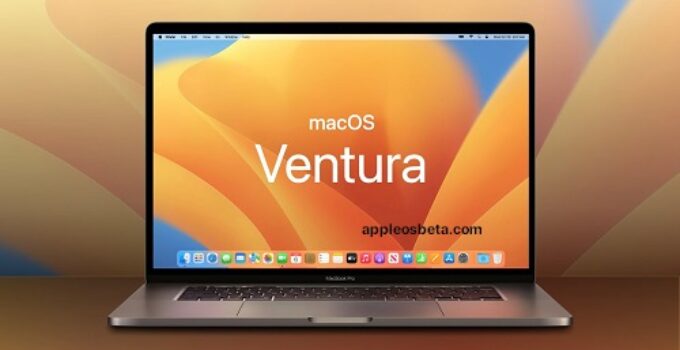Slowing down macOS Ventura? Try these ways to speed up your Mac. Some Mac users find that macOS Ventura is much slower than macOS Monterey or Big Sur, complaining about poor performance when doing the same tasks on a Mac.
Available update to tvOS 16.1.1, fixed bug that prevented app installation
If you’ve noticed that your Mac is noticeably slower and slower after updating to macOS Ventura, check out our tips to help improve your Mac’s performance.
1-Mac runs very slow after upgrading to macOS Ventura
If you have recently upgraded to macOS Ventura, your Mac may run slowly for a few days after the upgrade due to background tasks and indexing. This happens with every major operating system update.
The best way to fix your Mac running slowly after an update is to leave your Mac powered on (in the case of a MacBook) and not perform any tasks. This will allow the Mac to finish all background system processes related to indexing your files and other tasks faster, after which the performance should return to normal.
Usually, simply leaving your Mac on and connected to the network overnight is enough to fix problems after updating the operating system.
2-Old Mac and little RAM
macOS Ventura has stricter system requirements than previous releases of macOS, and some users have noticed that macOS Ventura runs slower on older Macs or Macs with more limited resources – not enough RAM or disk space.
Any new Mac model with 16GB of RAM or more and a good fast SSD will work pretty well with macOS Ventura. Macs with 8 GB or less of RAM and older hard disk drives (HDDs) can run significantly slower, especially when you have a lot of programs open at the same time.
3-Find Apps Wasting Mac Resources with System Monitor
Sometimes unexpected applications or processes can take up CPU or RAM, causing your computer to run slower.
Open System Monitor on Mac by pressing Command+Space to bring up Spotlight, type “System Monitor” and press Enter / Return.
First, sort processes by CPU usage (click on the % CPU column) to see which processes are using the CPU the most. Here you can see open but unused processes that might be causing your Mac to slow down.
If you see the kernel_task process constantly appearing at the top, this is normal and is due to the fact that you have many applications or browser tabs open, and the kernel is constantly processing them in virtual memory.
It is also common for the WindowServer process to use a lot of CPU, this happens for the same reason – there are a lot of active applications or media on the screen.
Google Chrome is a great web browser, but it’s notorious for using up a lot of system resources like RAM and CPU, so if it’s open with dozens of tabs or windows, it can slow down Mac performance. Using a more frugal browser like Safari can fix this problem, or just try to keep fewer windows and tabs open in Chrome whenever possible.
Advanced users can also try force quitting apps and processes that are CPU or RAM intensive, but be aware that force quitting apps can cause data loss in these apps, such as browser tabs.
You may also notice the ApplicationsStorageExtension process which is using a lot of resources to calculate the free space in the “storage” partition on Mac, you can just close it.
4-WindowServer CPU uses a lot of RAM
You may notice that the “WindowServer” process is consuming a lot of resources on your Mac. This usually happens because there are many windows or applications open on the Mac.
Closing windows, media windows, applications, browser tabs, and browser windows will allow WindowServer to reduce RAM and CPU usage. You can also try turning off the external monitor and see if the resource consumption is reduced.
You can also turn off the visual effects and transparency of macOS interfaces, this can also help reduce the resource consumption of the WindowServer process. But if you have dozens of applications and browser tabs open, this process will still use a lot of system resources to draw windows on the screen
5-Turn off visual effects and other decorations such as transparency and movement
Turning off visual effects on a Mac can help free up system resources.
- Open the Apple menu and go to System Preferences.
- Select “Accessibility” settings.
- Select Display settings.
- Activate the “Reduce Motion” and “Reduce Transparency” options
This will slightly change the appearance of macOS, turning off transparency on windows, making them brighter and lighter than the muted grays. But it should also reduce system resource usage, potentially improving performance.
Turning off transparency has always helped speed up your Mac, and this method works especially well on older computers with limited system resources
6-Tidy up your Mac desktop
If your desktop is littered with hundreds of files, it can affect the performance of your Mac.
This is because every thumbnail and file on the desktop uses resources to draw on the screen, so simply sorting files on the desktop into folders or hiding icons from the desktop can instantly speed up your Mac.
Another option is to hide all icons from the Mac desktop, this will disable the desktop (but not the Finder), preventing files from showing up on the desktop. But for most users, it will be enough to simply move all the files from the desktop to one separate folder (you can also use the smart sort on the desktop).
7-Install macOS Ventura updates
Apple continues to improve macOS Ventura and release software updates for the operating system, and when they come out, you should install them. Updates fix bugs that can cause performance issues.
- From the Apple menu, go to System Preferences, then select General and go to Software Update.
- Install all available software updates for Ventura.
8-Update all apps on Mac
Remember to keep your Mac apps up to date as they may be optimized for performance or fix bugs that affect performance.
Most apps can be updated through the App Store by going to App Store > Updates.
Some applications, such as Chrome, may be updated automatically or manually through the About Google Chrome menu item.
Install all available application updates for macOS Ventura, this will in any case have a good effect on the state of the operating system.
9-Slows down Wi-Fi or internet on Mac
Some users may have problems with slow Wi-Fi or Internet connections, such as website pages or applications that use the Internet to open slowly. Most likely the problem is not in a slow Mac, but in the Internet connection.
In this case, you can try the solutions from our article – How to fix Wi-Fi problems in macOS.
10-Why Mac freezes or slows down in certain applications
This problem may not be specific to macOS Ventura, you probably have some other application that consumes a lot of system resources, such as Google Chrome with tons of open windows and tabs, this can slow down performance in other applications.
The easiest way to get rid of lag in such situations is to close other applications that use a lot of system resources.
11-Braking in preview?
Performing simple tasks like rotating or resizing images in Preview on Mac used to be instantaneous, but some users have reported that macOS Ventura Preview has issues with freezes or actions that used to take seconds to take minutes to complete. for example, resizing a large image.
The reason here may be the same as in the previous method – other open applications use too many resources, try closing one or more applications. After that, using the preview should speed up.
12-Is Google Chrome slow on macOS Ventura?
Some users have reported that Google Chrome is slow on macOS Ventura.
If you have the same problem, then be sure to install all the updates available for Google Chrome. Perhaps you have auto-update disabled and you have not updated your browser for a long time, so you are using an old version that is not optimized for Apple Silicon (of course, if you have such a processor, and not Intel).
Also, the easiest way to speed up Chrome’s performance is to close all windows and tabs, which will free up a lot of memory and system resources, and also try disabling extensions you don’t use.
You can also try a different browser for a while, such as Safari, which is more optimized for macOS.
13-Install macOS Ventura from scratch
This is the most extreme way, but it is often the most effective. Ideally, it’s always better to install a new operating system on a blank, formatted hard drive, and then deploy your backup to it or install the necessary programs as you need them.
With the release of macOS Monterey, a very easy way to reinstall macOS has appeared, in macOS Ventura this method has been preserved, so back up your important files and try our instructions for resetting your Mac to factory settings.
Watch your Mac running with a clean operating system to rule out macOS issues. And then start installing all your apps one by one.



